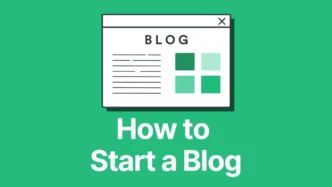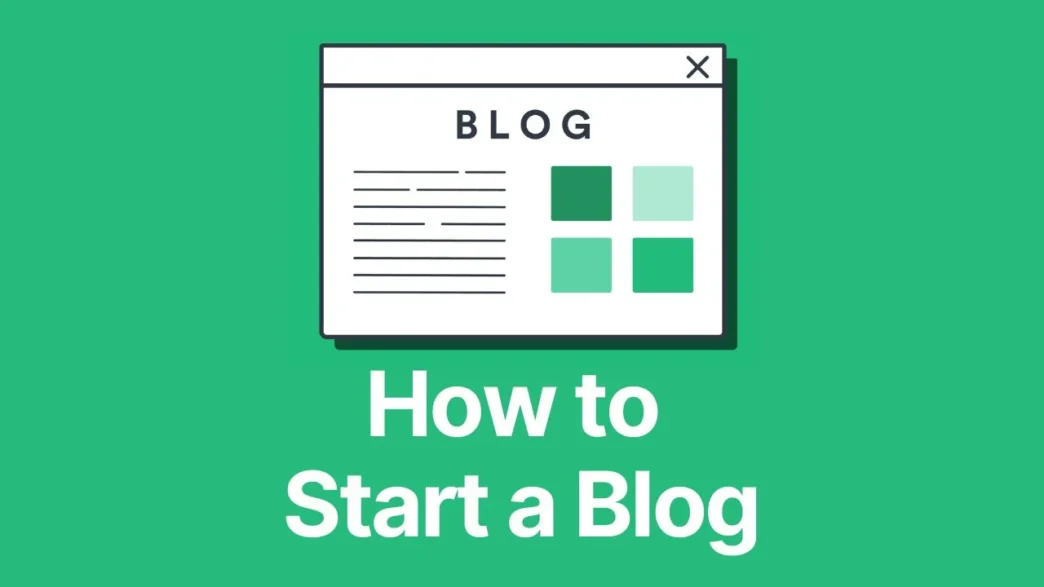What is a Blog?
A blog is a type of website that focuses mainly on text content to deliver information about a specific niche. The content is organized into tags and categories to make it easy to navigate.
Bloggers always write from a personal perspective that comes directly from their readers. In addition, many blogs have a comment section where visitors can post their opinions. Interacting with your readers in the comment section helps in creating further connections.
Table of contents
- What is a Blog?
- Follow these steps to start a successful Blog
- 1. Selecting a Niche for your Blog
- 2. Choose a name for your Blog
- 3. Register your Domain Name (.com, .net, or .org)
- 4. Get a reliable Web Hosting
- 5. Setting up WordPress for your Blog
- 6. Creating a Business Email Address
- 7. Creating Social Media Accounts
- 8. Installing Necessary Plugins
- 9. Posts Length and Frequency
- 10. Create Your First Blog Post
- 11. Market Your Blog
- FAQ’s
Follow these steps to start a successful Blog
Starting a blog doesn’t seem a big deal; it only involves setting up a website and writing. But believe me, it’s not that easy. If you follow these steps with proper attention, it can be a piece of cake for you.
Here’s the complete process you need to follow before starting a blog.
1. Selecting a Niche for your Blog
The main purpose of your blog is to benefit other people by providing relevant information according to their searches. To write such a blog from which people can get solutions or knowledge of their problems, you can do a little research to see what they are searching for and why.
It will help you write more concise content and help increase engagement on the blog post. The more accurate information you will provide in your blog post, the more readers will find it helpful.
2. Choose a name for your Blog
When you have decided which topics you will write about, the next step is to select a unique name for your blog. It should be easy to remember and simple to pronounce. Preferably, your blog name should contain your niche keywords or at least be related to your blog category.
If you’re having trouble choosing a good name for your blog, you can try some online blog name generators. These name generators allow you to input a few keywords according to your niche and give you potential blog names that you can choose from.
3. Register your Domain Name (.com, .net, or .org)
A domain is like a unique name for your blog on the internet. It is a URL that will end on .com, .net, or .org, etc.
The domain name should be short, concise, and almost the same as your blog name. So, when you share it with your family or friends they can easily remember. They will be able to search your domain easily and will not face any kind of confusion.
Recommended: The best domain extension is .com in terms of SEO and reader trust factor. But if it’s not available, you can try buying .net, .org, or some other top-level domain (TLD) extensions.
You can use different domain name providers to check domain availability and register your domain name. Some of the top companies for registering a domain are GoDaddy, Namecheap, Hostinger, and HostGator.
One thing to keep in mind with domain names is that registering a good domain name can be highly competitive and costly.
4. Get a reliable Web Hosting
Web Hosting is a storage space in which you store files on your website like text, images, videos, styles, fonts, and permission files.
Just because you have a domain name doesn’t mean you have a website. You also need web hosting to start developing your website.
Recommended: HOSTINGER is the most reliable hosting provider at the time of writing. (TechBloggie is running on it, and you have seen site performance)

If you need some help setting up your blog on Hostinger, you can always reach the TechBloggie team here: support@tecbloggie.com [It’s FREE]
5. Setting up WordPress for your Blog
Now that you have a domain name and web hosting, it’s time to start setting up your blog. To install WordPress, just click on the instant installer [a cool feature given by Hostinger], and it will start a wizard. Follow the onscreen instructions; it will take 2 minutes to install WordPress for your blog.
When setting up your WordPress blog, you’ll also need to choose a theme. Always select a lightweight theme that loads faster and provides an excellent user experience. Some of the most commonly used blog themes are NewsPaper, Neon, and Bimber.
6. Creating a Business Email Address
Stay updated with your business email about your blog. When someone leaves a comment, any error occurs, or some sort of important thing happens about your blog, you must be informed via email.
I am sure that you probably don’t want your old email inbox to be filled with updates and notifications. As you have your own domain name and web hosting, you can receive website-related emails in business email inboxes.
By creating a custom mail address, you can categorize the queries submitted by your readers, like support, billing, guest posts, or feedback. Respond to questions from readers and chat with them on an additional weekly basis.
Your email address will be yourdomain@.com, but you can create a forwarder in your hosting to send all messages to your Gmail that are being sent as business emails.
7. Creating Social Media Accounts
Social media can be a great way to promote your blog and give it exposure to a large audience. Some of the most popular social media platforms today include Twitter, Instagram, Facebook, and TikTok. If your post is related to a professional or educational topic, then LinkedIn can be a good platform for sharing content.
You can use your social media accounts to promote your small business posts. Whenever you write a new blog post, share it on your Facebook, LinkedIn, and Twitter.
8. Installing Necessary Plugins
Plugins are additional components in WordPress that enhance the core functionality of the website. Just like TechBloggie is using multiple plugins like Yoast SEO, LiteSpeed Cache, and reCaptcha.
Your blog must have these plugins for better performance. Some of these are paid, but you can start with their Free version in the beginning.
- Yoast SEO: For Improving Google Rankings
- LiteSpeed Cache: For Improving Website Speed
- Google Local Fonts: Helps in using local fonts to save network traffic
- Contact Form 7: To create a simple contact form that can send emails
- Advanced reCaptcha: To Integrate Google reCaptcha to keep spammers away [Read Complete Guide on how to install Google reCaptcha in your WordPress website]
- All-in-one Migration: To back up your website regularly. [Read Complete Guide on How to Backup your website using All-in-one Migration Plugin]
9. Posts Length and Frequency
Writing posts is an important part of running a successful blog. You should figure out how much length of posts you will be writing on your blog. Keep it to the limit so that your reader doesn’t get bored and leave the page; instead, write what it takes to explain the issue.
If the topic needs 1,000 words, write them, and if it needs 3,500, also write them. But don’t make it artificially long to just add content to the blog post.
10. Create Your First Blog Post
Your first post is an important opportunity to make a first impression. Take your time to write a well-thought-out post. You can use this post to introduce yourself. Whatever you do, what you will be writing, what this blog is about.
You don’t need to write an introductory post because you have already put all the information about yourself and your blog on the “About Us” page. You can start from a trending topic in any of your blog categories.
11. Market Your Blog
You may have been able to promote your blog to get organic traffic. There is no replacement for marketing to drive traffic to your website. Every time you make a new post, you should post a link on your social media accounts so more people can read it.
You can also use PPC and PPM advertising to promote your blog to a larger audience. Whatever you do, marketing is an essential tool when you’re building your audience.
FAQ’s
Generally either through affiliate marketing or display advertising by ad networks. Some of them make handsome incomes through sponsored posts.
The definite answer is WordPress. The most popular free blogging platform, it provides you with plenty of templates and customizable features. If you want more in-depth control of your features and built-in analytics, this is the best platform for a free blog.
The amount of money that bloggers can make varies widely depending on the niche, industry, and quality of the traffic. Most of them with 1,000 views usually make an RPM of $20-35 on average.

